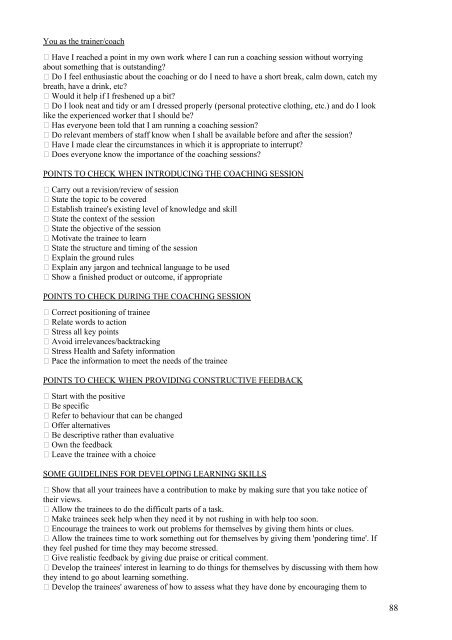How to Perform On-the-job Training - Dean Amory
According to The Encyclopedia of Business, ©2000 Gale Cengage, On-the-job training is by far the predominant form of job training. Studies also indicate that it is the most effective form of job training. Yet, it also represents a significant investment considering that roughly 30% of a new worker's time is spent in on-the-job training during the first 90 days of employment, that productivity of experienced workers assigned to train new workers may decrease during the training period, and that new workers may make expensive mistakes. Both companies and workers therefore profit largely from the presence of simple, but complete trainee and trainer guides that allow for executing OJT in a structured way. “How to perform on-the-job training”, has the information, techniques and tips that will allow you to implement a professional OJT training program. The book also includes all the tools, documents and checklists necessary for setting up a qualitative and efficient skills training program for OJT coaches
According to The Encyclopedia of Business, ©2000 Gale Cengage, On-the-job training is by far the predominant form of job training. Studies also indicate that it is the most effective form of job training. Yet, it also represents a significant investment considering that roughly 30% of a new worker's time is spent in on-the-job training during the first 90 days of employment, that productivity of experienced workers assigned to train new workers may decrease during the training period, and that new workers may make expensive mistakes.
Both companies and workers therefore profit largely from the presence of simple, but complete trainee and trainer guides that allow for executing OJT in a structured way.
“How to perform on-the-job training”, has the information, techniques and tips that will allow you to implement a professional OJT training program. The book also includes all the tools, documents and checklists necessary for setting up a qualitative and efficient skills training program for OJT coaches
You also want an ePaper? Increase the reach of your titles
YUMPU automatically turns print PDFs into web optimized ePapers that Google loves.
You as <strong>the</strong> trainer/coach<br />
Have I reached a point in my own work where I can run a coaching session without worrying<br />
about something that is outstanding?<br />
Do I feel enthusiastic about <strong>the</strong> coaching or do I need <strong>to</strong> have a short break, calm down, catch my<br />
breath, have a drink, etc?<br />
Would it help if I freshened up a bit?<br />
Do I look neat and tidy or am I dressed properly (personal protective clothing, etc.) and do I look<br />
like <strong>the</strong> experienced worker that I should be?<br />
Has everyone been <strong>to</strong>ld that I am running a coaching session?<br />
Do relevant members of staff know when I shall be available before and after <strong>the</strong> session?<br />
Have I made clear <strong>the</strong> circumstances in which it is appropriate <strong>to</strong> interrupt?<br />
Does everyone know <strong>the</strong> importance of <strong>the</strong> coaching sessions?<br />
POINTS TO CHECK WHEN INTRODUCING THE COACHING SESSION<br />
Carry out a revision/review of session<br />
State <strong>the</strong> <strong>to</strong>pic <strong>to</strong> be covered<br />
Establish trainee's existing level of knowledge and skill<br />
State <strong>the</strong> context of <strong>the</strong> session<br />
State <strong>the</strong> objective of <strong>the</strong> session<br />
Motivate <strong>the</strong> trainee <strong>to</strong> learn<br />
State <strong>the</strong> structure and timing of <strong>the</strong> session<br />
Explain <strong>the</strong> ground rules<br />
Explain any jargon and technical language <strong>to</strong> be used<br />
Show a finished product or outcome, if appropriate<br />
POINTS TO CHECK DURING THE COACHING SESSION<br />
Correct positioning of trainee<br />
Relate words <strong>to</strong> action<br />
Stress all key points<br />
Avoid irrelevances/backtracking<br />
Stress Health and Safety information<br />
Pace <strong>the</strong> information <strong>to</strong> meet <strong>the</strong> needs of <strong>the</strong> trainee<br />
POINTS TO CHECK WHEN PROVIDING CONSTRUCTIVE FEEDBACK<br />
Start with <strong>the</strong> positive<br />
Be specific<br />
Refer <strong>to</strong> behaviour that can be changed<br />
Offer alternatives<br />
Be descriptive ra<strong>the</strong>r than evaluative<br />
Own <strong>the</strong> feedback<br />
Leave <strong>the</strong> trainee with a choice<br />
SOME GUIDELINES FOR DEVELOPING LEARNING SKILLS<br />
Show that all your trainees have a contribution <strong>to</strong> make by making sure that you take notice of<br />
<strong>the</strong>ir views.<br />
Allow <strong>the</strong> trainees <strong>to</strong> do <strong>the</strong> difficult parts of a task.<br />
Make trainees seek help when <strong>the</strong>y need it by not rushing in with help <strong>to</strong>o soon.<br />
Encourage <strong>the</strong> trainees <strong>to</strong> work out problems for <strong>the</strong>mselves by giving <strong>the</strong>m hints or clues.<br />
Allow <strong>the</strong> trainees time <strong>to</strong> work something out for <strong>the</strong>mselves by giving <strong>the</strong>m 'pondering time'. If<br />
<strong>the</strong>y feel pushed for time <strong>the</strong>y may become stressed.<br />
Give realistic feedback by giving due praise or critical comment.<br />
Develop <strong>the</strong> trainees' interest in learning <strong>to</strong> do things for <strong>the</strong>mselves by discussing with <strong>the</strong>m how<br />
<strong>the</strong>y intend <strong>to</strong> go about learning something.<br />
Develop <strong>the</strong> trainees' awareness of how <strong>to</strong> assess what <strong>the</strong>y have done by encouraging <strong>the</strong>m <strong>to</strong><br />
88


















